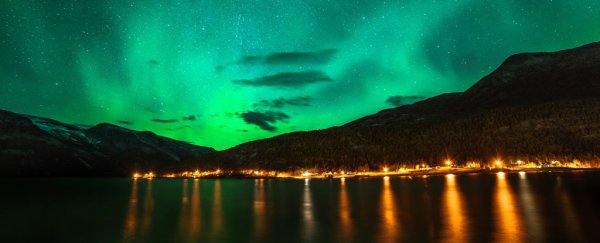If you're still riding that high from seeing the recent total solar eclipse and you want to keep the party going, now's your chance to see another of the night sky's wonders: an aurora. That said, a totally full Moon is going to try and wreck the party.
NASA announced that two powerful flares were just emitted on the surface of the Sun, casting coronal mass ejections in our direction. Over the course of the next couple of days, this should generate aurora activity in the sky outside the regular viewing areas.
In other words, if you normally don't see the northern lights where you live, you might want to spend a few hours outside tonight and tomorrow.
Look up, you might see something.
This morning, the Sun released the most powerful solar flare recorded since 2008. Here's what our satellite saw: https://t.co/mk2540AdtV pic.twitter.com/7hVektV682
— ARCHIVED - NASA Sun & Space (@NASASun) September 6, 2017
The first flare, an X2.2 event, peaked on September 6 at 5:10 am EDT and the second X9.3 flare went off at 8:02 am. Both of which came from the sunspot group AR 2673.
If you've still got those eclipse glasses, take a look at the Sun, and you should be able to see the sunspot group right now. There are two groups of sunspots close to one another, AR 2673 and AR 2674. This follows up the X4 flare emitted on September 4th.
Solar astronomers measure flares using a similar scale to other natural events, with a series of designations. The smallest are A-class, then B, C, M and finally X. Each level within the rating accounts for double the strength; it's exponential.
So, an X2 is twice as powerful as an X1, etc. The most powerful flare ever recorded was an X28 in 2003, so today's flare is still comparatively weak to that monster.
But, measuring in at X9.3, today's flare is the strongest in almost a decade. The last one this strong was back in 2008. And NOAA is predicting that this flare could cause radio blackouts across the sun-facing side of the Earth.
If you're out at sea and depending on your radio transmissions, don't be surprised if you're getting a lot of static today.
How do you stand the best chance of seeing auroras? My favourite tool comes from NOAA's 3-day aurora forecast. It shows you a 3-day predictive simulation for what the solar storm should do as it buffets the Earth's magnetosphere.
You can run the simulation backwards and forwards, and you're looking glowing green areas to come across your part of the world.
But even if it doesn't look like you're going to see the auroras, I still think it's worth trying. Even if you don't get an aurora directly overhead, you can sometimes see it on the horizon, and it can be surprisingly beautiful.
Here's my timelapse video of auroras on the horizon.

The big problem, of course, is the Moon. Tonight is also a full Moon, which means that awful glowing ball is going to rise just after sunset and blaze across the sky all night. You're going to have a rough time seeing all but the brightest auroras. But I still think it's worth trying.
If you want to maximise your chances of seeing an aurora, check out the Space Weather site on a regular basis.
There are also services that'll send you a text message when there's a powerful aurora going on in your area (just Google "aurora alert text messages").
And of course, there are handy apps that'll make your phone beep boop when there are auroras overhead. I use an app called Aurora Alert.
We've had three powerful flares in the last couple of days, which means that the Sun is feeling a little frisky. There could be more, and they could happen after the full Moon is over, and we've got some alone time with the dark sky.
So stay on top of the current space weather, spend time outside, and keep your eyes on the sky. You might get a shot at seeing an aurora.
And once you've seen one, you'll be hooked.
This article was originally published with Universe Today. Read the original article.
